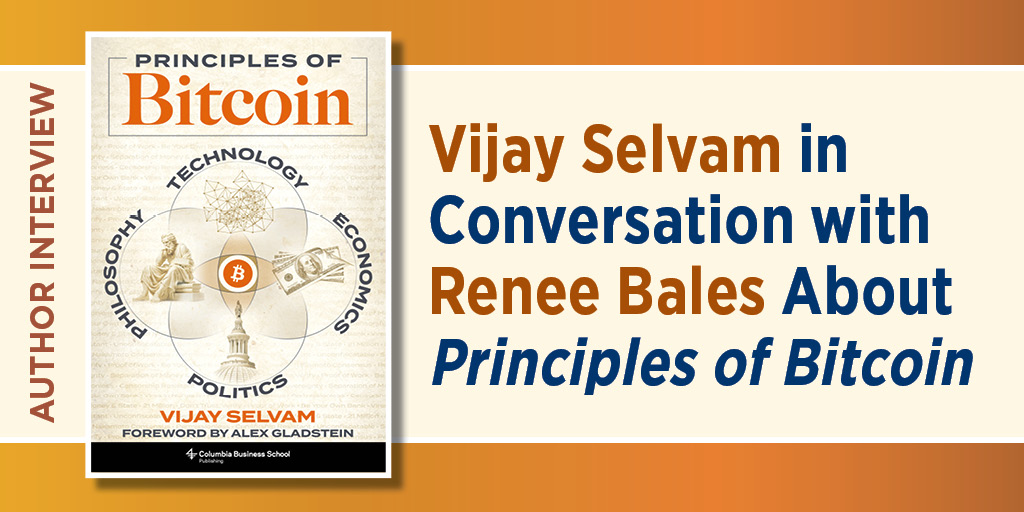Vijay Selvam in Conversation with Renee Bales About Principles of Bitcoin

Despite the ubiquity of its name, Bitcoin remains an elusive subject among economists and the general public alike. Given its rapid rise to prominence—met by some with enthusiasm and by others with skepticism—the line between fact and fiction is often been blurred, with little reliable scholarship on which to base conclusions about the technology and its legitimacy. What actually is Bitcoin? What are its implications for how we think about money?
In Principles of Bitcoin: Technology, Economics, Politics, and Philosophy, the lawyer and finance expert Vijay Selvam answers these questions and more through a first-of-its-kind study of Bitcoin’s past, present, and future. Touching on everything from computer science to international politics, the book takes a closer look at the truths and misconceptions stemming from discussions about cryptocurrency. Selvam’s analysis is uniquely and necessarily multidisciplinary, aiming not only to explain the technology behind Bitcoin but also to position said technology within its economic, political, and philosophical contexts. In this interview, Selvam and our Renee Bales discuss the benefits of this framework, the challenge of making Bitcoin accessible, and Selvam’s perspective on Bitcoin’s future.
Renee Bales: Something that distinguishes your book from other scholarship on Bitcoin is its “first-principles-based” approach. How would you define this approach, and why is it a useful framework for understanding this topic?
Vijay Selvam: “Semantic satiation” is a phenomenon wherein a word is repeated so often that it loses its meaning. That’s exactly what happened with Bitcoin. Repeated endlessly in headlines and lumped together with buzzwords like “blockchain,” “Web3,” “metaverse,” and “NFTs,” its true significance has been blurred and misunderstood by the general public. This book aims to cut through that noise by going back to first principles. It asks the fundamental questions: What was Bitcoin’s core innovation? Why does it matter?
The problem is that Bitcoin does not neatly fit into any known mental model. This is unsurprising because there has never been anything like Bitcoin before in history. It is a new kind of system—monetary, technological, social, and political all at once. People unfortunately make the mistake of trying to fit a square peg in a round hole, thereby ending up with a misguided impression. This book encourages people to start again, to go back to the basics and analyze Bitcoin from the ground up.
Bales: The concept of cryptocurrency has a reputation for being abstract and difficult to fully grasp. What audience did you have in mind while writing the book, and how did you approach making the topic accessible to those who may be unfamiliar with its intricacies?
Selvam: You are correct—cryptocurrency often feels abstract, technical, and hard to decode. My goal in writing this book was to provide an easy to understand technical explanation of Bitcoin that is relatable to general readers while focusing more on the question of why the innovation matters. The book is for anyone who values logic, clarity, and reasoned thinking. Whether you are a student, a curious thinker, a seasoned investor, or someone with an interest in monetary history, economics, or philosophy, this book may prove useful and enjoyable. I also wrote it for students seeking frameworks, practitioners and professionals exploring investment cases with intellectual honesty (because conviction in Bitcoin is directly proportional to understanding), and even for members of the older generation who appreciate the long arc of monetary history and are open to questioning today’s political and financial systems. I tried to avoid technical jargon and instead focus on conceptual and philosophical understanding. The aim was to create an accessible guide that respects the reader’s intelligence, regardless of professional or technical background.
Bales: How has your extensive experience in traditional financial systems contributed to your unique perspective on Bitcoin?
Selvam: My perspective on Bitcoin is deeply shaped by my experience in traditional finance. During the 2008 financial crisis, as an attorney on Wall Street, I witnessed firsthand the skewed and perverse incentive structures that underpin our monetary system. That period revealed structural flaws underlying unchecked leverage, moral hazard, bailouts, and the fundamental disconnect between the financial system and the public it is meant to serve.
Having spent more than a decade at Goldman Sachs working on structured credit, derivatives, and capital markets, I had a front row seat to global financial markets and incentives structures. When I encountered Bitcoin, I was not drawn to it as a speculative asset, but rather as a radical solution to various systemic problems that were staring me in the face for years.
Bales: In your view, what is the biggest misconception about Bitcoin?
Selvam: The biggest misconception about Bitcoin is that it is just another cryptocurrency among the 20,000 others. Bitcoin is a once-in-history invention. Its architecture, incentive structure, and emergence were profoundly path dependent. It was born during a unique moment in time—the 2008 financial crisis, which carries great symbolism—with no leadership, no pre-mine, and no VC-backed funding. These conditions created a system that is uniquely decentralized in a manner impossible to retroactively engineer or replicate. Every other cryptocurrency since has emerged in Bitcoin’s shadow and in an environment skeptical of imitators and scammers.
To truly grasp what makes Bitcoin singular, you have to study incentive design, game theory, and consensus mechanisms. Only then can you see why no other protocol, no matter how innovative or flashy, can replicate the trustless neutrality and credibility that Bitcoin has earned over time. Digital scarcity is not simply borne out of lines of C++ code. It is shaped by a very specific sequence of unrepeatable events. Network effects, the Lindy effect, the 10x improvement rule, and Schelling points, among other forces, contribute to Bitcoin as the singularity in digital money.
Bales: One striking aspect of Bitcoin mentioned in the book is the speed of its rise—it became worth over $1 trillion in just fifteen years. Where do you think Bitcoin is headed in the next fifteen years?
Selvam: It is actually well over $2 trillion as we speak! I cannot really make a price prediction, but a useful comparison is to gold, which is now over $23 trillion in market cap. Bitcoin can be called “digital gold,” with greater scarcity, portability, divisibility, and verifiability than actual gold. Plus, Bitcoin is censorship resistant, permissionless, and unconfiscatable, and this would suggest that it should have an equal or higher market cap over the next fifteen years.
Bales: Do you have any final thoughts you’d like to share on this topic?
Selvam: My book presents a multidisciplinary and holistic perspective of Bitcoin because Bitcoin’s elusiveness stems from its intersection with numerous disciplines. Viewing it solely through a technological lens might render it seemingly antiquated without acknowledging its profound implications in the realms of monetary economics. Contemplating its geopolitical potential without understanding its technological indestructibility could lead one to believe that governments will inevitably crush it. And focusing on all of the above without delving into its philosophical foundations might lead one to overlook its societal significance and enduring cultural narrative. Humans are wired to look at the big picture rather than learn things in silos: the whole is greater than the sum of its parts. This has been the guiding principle adopted by the book.






